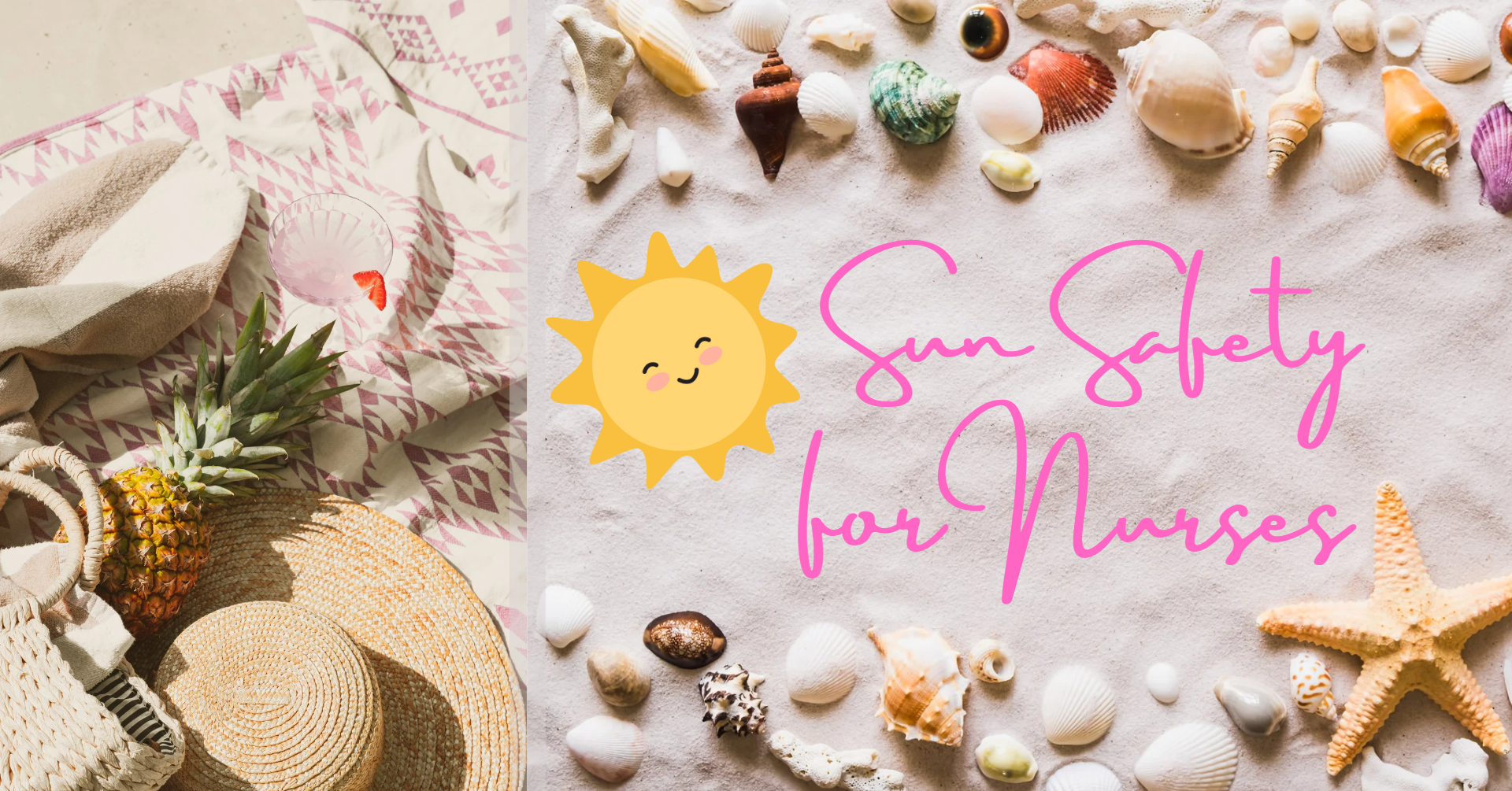Healthy Nurse, Healthy Nation™ Blog - Sun Safety Tips For Nurses
Published
Nurses understand the dangers of spending too much time in the sun and many of us practice sun safety measures to protect against skin cancer, but protecting against skin cancer is a topic that should stay top of mind. Check out these Sun Safety Tips for Nurses.
 According to American Nurses Association’s 2014 Health Risk Appraisal, 88 percent of us wear sunscreen with an SPF 15 or higher when outdoors for more than an hour. Plus, 89 percent of us completely avoid artificial tanning.
According to American Nurses Association’s 2014 Health Risk Appraisal, 88 percent of us wear sunscreen with an SPF 15 or higher when outdoors for more than an hour. Plus, 89 percent of us completely avoid artificial tanning.
Despite this good news, according to the Skin Cancer Foundation, there are more new cases of skin cancer each year than the combined incidence of breast, prostate, lung, and colon cancer. Protecting against skin cancer is a topic that should stay top of mind.
Melanoma is a type of skin cancer that affects the cells that produce pigment.
The Melanoma Research Foundation says 90 percent of melanoma cases are preventable by limiting sun exposure and by diagnosing the disease as early as possible. Use these tips to prevent skin cancer from Ana Fadich, MPH, CHES, Vice President of the Men's Health Network.
Reapply sunscreen often
Putting sunscreen on in the morning is a great start, but reapplication is important. Reapply every two hours if you’re outdoors. If you are inside for most of the day, reapply at least 15 minutes before going outside again.
Stay in the shade
If you can, avoid spending time outdoors when the sun is strongest (from 10 a.m. to 4 p.m.). If you are outside, stay in the shade. You’ll protect yourself from the sun’s rays and will stay cooler so sunscreen will last longer as well.
Store sunscreen everywhere
Since you have to reapply often, stash bottles of sunscreen everywhere you can. They make small bottles that can be attached to purses or key chains. Keep some in your car, at your desk, and near all entrances of your home. Toss those with an outdated expiration.
Keep covered
Wear a wide-brimmed hat to protect your face. Wear loose-fitting long sleeves and pants in the sun. Consider purchasing SPF protective clothing.
Use sunscreen on cloudy days
The sun can burn your skin through the clouds, so you still need protection when it’s overcast. People often get worse burns on those days, because they are not as vigilant about reapplying.
Be mindful indoors
Windows are also not protected from ultraviolent (UV) light, so you can still get sun exposure through windows in your home or at work and while driving or sitting in a car.
Use UVA/UVB protection
Always choose sunscreen that has protection against both types of UV rays. According to the Skin Cancer Foundation, long-wave ultra violet rays (UVA) penetrate the skin’s deepest layer, while shortwave ultraviolet rays (UVB) tend to damage the more superficial epidermal layers. Look for both UVA and UVB protection on sunglasses as well. Exposure to the sun can damage sensitive cells in the eyes and affect vision. The CDC recommends a broad spectrum sunscreen with an SPF 15 or higher.
Remember hard-to-reach spots
A common area for skin cancer is between the toes because people often wear flip-flops and don’t apply sunscreen to their feet. Other common areas for skin cancer include:
Mind your moles
Use the Melanoma ABCs guide from the Men’s Health Network to spot potential issues.
Were these tips helpful to you? Share your comments, tips, and tricks in our discussion or join the conversation on our Facebook, Twitter, or Instagram. Tag us with #HealthyNurse.

Have you joined Healthy Nurse, Healthy Nation (HNHN)!Join us today!
Sign up for our monthly challenges!
Updated 12/1/22
 According to American Nurses Association’s 2014 Health Risk Appraisal, 88 percent of us wear sunscreen with an SPF 15 or higher when outdoors for more than an hour. Plus, 89 percent of us completely avoid artificial tanning.
According to American Nurses Association’s 2014 Health Risk Appraisal, 88 percent of us wear sunscreen with an SPF 15 or higher when outdoors for more than an hour. Plus, 89 percent of us completely avoid artificial tanning.Despite this good news, according to the Skin Cancer Foundation, there are more new cases of skin cancer each year than the combined incidence of breast, prostate, lung, and colon cancer. Protecting against skin cancer is a topic that should stay top of mind.
Melanoma is a type of skin cancer that affects the cells that produce pigment.
- Unlike other skin cancers, melanoma grows quickly and can spread to other parts of the body.
- Melanoma accounts for less than one percent of skin cancer cases, but the vast majority of skin cancer deaths.
- Caught early and treated, melanoma is almost always curable.
- Men usually wait longer than women before getting their skin checked, and are nearly twice as likely to die from melanoma, according to the Men’s Health Network.
The Melanoma Research Foundation says 90 percent of melanoma cases are preventable by limiting sun exposure and by diagnosing the disease as early as possible. Use these tips to prevent skin cancer from Ana Fadich, MPH, CHES, Vice President of the Men's Health Network.
Reapply sunscreen often
Putting sunscreen on in the morning is a great start, but reapplication is important. Reapply every two hours if you’re outdoors. If you are inside for most of the day, reapply at least 15 minutes before going outside again.
Stay in the shade
If you can, avoid spending time outdoors when the sun is strongest (from 10 a.m. to 4 p.m.). If you are outside, stay in the shade. You’ll protect yourself from the sun’s rays and will stay cooler so sunscreen will last longer as well.
Store sunscreen everywhere
Since you have to reapply often, stash bottles of sunscreen everywhere you can. They make small bottles that can be attached to purses or key chains. Keep some in your car, at your desk, and near all entrances of your home. Toss those with an outdated expiration.
Keep covered
Wear a wide-brimmed hat to protect your face. Wear loose-fitting long sleeves and pants in the sun. Consider purchasing SPF protective clothing.
Use sunscreen on cloudy days
The sun can burn your skin through the clouds, so you still need protection when it’s overcast. People often get worse burns on those days, because they are not as vigilant about reapplying.
Be mindful indoors
Windows are also not protected from ultraviolent (UV) light, so you can still get sun exposure through windows in your home or at work and while driving or sitting in a car.
Use UVA/UVB protection
Always choose sunscreen that has protection against both types of UV rays. According to the Skin Cancer Foundation, long-wave ultra violet rays (UVA) penetrate the skin’s deepest layer, while shortwave ultraviolet rays (UVB) tend to damage the more superficial epidermal layers. Look for both UVA and UVB protection on sunglasses as well. Exposure to the sun can damage sensitive cells in the eyes and affect vision. The CDC recommends a broad spectrum sunscreen with an SPF 15 or higher.
Remember hard-to-reach spots
A common area for skin cancer is between the toes because people often wear flip-flops and don’t apply sunscreen to their feet. Other common areas for skin cancer include:
- Eyelids
- Earlobes
- Tops of feet
- Scalp (especially where hair is parted)
Mind your moles
- Examine your skin in a mirror often.
- Check your loved ones’ skin often for suspicious moles and have them check yours.
- Make a yearly appointment with a dermatologist for a full body scan.
- Use apps to keep track of moles and any changes.
Use the Melanoma ABCs guide from the Men’s Health Network to spot potential issues.
- Asymmetry: One half does not look like the other half
- Border: Irregular, jagged, or uneven edges
- Color: More than one color (tan, brown, black, white, red, or blue)
- Diameter: Size of mole bigger than pencil eraser (6 mm)
- Evolving: Changes color, size, or thickness
Were these tips helpful to you? Share your comments, tips, and tricks in our discussion or join the conversation on our Facebook, Twitter, or Instagram. Tag us with #HealthyNurse.

Have you joined Healthy Nurse, Healthy Nation (HNHN)!Join us today!
Sign up for our monthly challenges!
Updated 12/1/22
Blog Safety
06/05/2017 11:05am CDT



Post a Comment or Question